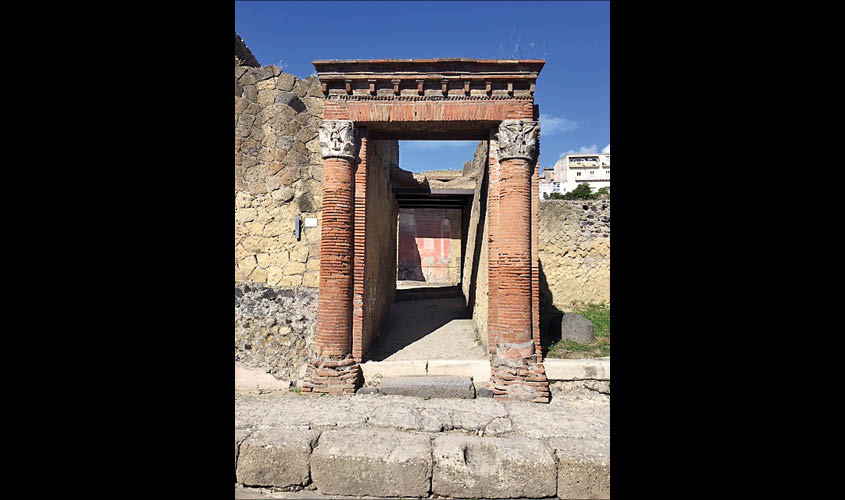A visit to the Amalfi coast in Southern Italy shows how the Western World is indebted to the innovations of the Roman civilisation. This dramatic coastline of monumental cliffs and improbable roads displays some extraordinary and charming architecture, hotels, homes and villas stacked up on minute terraces carved out of the mountainsides. The popular villages of Sorrento, Positano, Amalfi and Ravello have some of Italy’s finest restaurants serving the freshest fish from the Mediterranean and the plumpest fruit and vegetables from the terraced vineyards, orchards and pastures. This stretch of coast has such an exceptional landscape, cultural and historical merit that UNESCO listed the area as a World heritage Site in 1997.
This reporter arrived on Capri where cultural tourism is an economic saviour, the island has been inhabited since prehistoric times but Capri’s fame stems from Emperor Tiberius’ retirement in AD27, Tiberius secured the fortunes of Rome (14CE-37CE) and posthumously contributed to Capri’s thriving tourist economy. Tiberius’ many villas are esteemed for their beautiful gardens,architectural ingenuity and complex water reservoirs fed by gravity; but infamous for their prisons, underground dungeons and places of execution, notably a cliff top where victims were launched into the foamy sea while Tiberius watched from a viewing platform. Tiberius’ reputed thrill seeking could have been a source for Game of Thrones. Capri is totally picturesque thus the non-history buff has the Blue Grotto and plenty of churches, monasteries to visit and mountain hikes but beware the steps are not for the fainthearted. The island remained relatively obscure until 1806 when the British Fleet arrived and fortified the island, following the Napoleonic Wars it was returned by the French to Ferdinand King of Naples in 1813. Ever since it has been a favourite holiday and second home destination for Europeans, particularly the British, Germans and Russians.
Amalfi’s prosperity came from its privileged relationship with the Byzantine Empire, Amalfi built ships, developed trade routes to Asia and it is said that the local Flavio Gioja invented the sailor’s compass as we recognise it today;during the middle ages Amalfi became a maritime superpower building merchant ships and warships. Most of old Amalfi disappeared into the sea during the earthquake of 1343. Today Roman Catholic pilgrims flock to the C9th Duomo Cathedral dedicated to the Apostle Saint Andrew, built in Arab/Saracen-Norman- Romanesque styles, the remains of St Andrew were reportedly brought here from Constantinople in 1206 during the Fourth Crusade, a part of the Apostle’s skull remains in the elaborately decorated crypt.
From the pretty village of Positano where Japanese and South Koreans love to visit, we travelled to Pompeii and Herculaneum. Pompeii is dominated by the enigmatic volcano Vesuvius, the city had a checkered political history from 600BC until Romanisation in 200BC, we were told the site is 165 acres and only 14,000 people lived there. The restoration attracts 4million foreign visitors every year. We were informed their main trading commodity was red wine. The ancient city planners did a tremendous job, the city is built on a grid like New York, the streets were drained, bollards stopped chariots from entering the public areas, the courthouse, electoral commission and government administration are adjacent to each other, all overlooked by the head of Zeus/Jupiter. There are still water fountains where the water was delivered by poisonous lead piping, the lead came from UK and Spain. Gymnasiums and swimming pools, hot bathhouses with the water heated from under the floor by boiling water pumped from coal fired vats. Houses had grand atriums and ornately decorated rooms specific for entertaining, bedrooms and toilets much as we have now. At the marketplace all the amphorae are found and exhibited, there are amphitheatres, a gladiatorum, what are known to be restaurants, theatres, temples and bordellos. The red-light district is the only one on a curved street so the folks could disappear quickly from view. These Romans had no inhibitions about nakedness or sex, statues and paintings of male and female physical perfection decorated all the venues and homes, the bordello has an illustrated menu. Romans shared the same Gods as Greeks, giving them new names and sometimes new powers to their counterparts Poseidon/Neptune, Eros/Cupid, Ares/ Mars but Apollo was always Apollo. There are some intriguing parallels with Indian civilisation such as the Sanatan Dharma right-handed swastika pattern mosaic on the floor of some houses, what looks like Shiva lingas in the streets that are touched for good luck, with other lingams on the walls of or inside the houses. The Gladiators training ground is similar to a Kalarippayattu exercise area in Thiruvananthapuram. Pompeii was a business centre, a democracy where merchants had fabulous houses and slaves were powerful if they played their cards right, until it was all extinguished by the Mount Vesuvius eruption in 79AD and time stood still buried in a pyroclastic cement, the excavations continue.
In Herculaneum after the God Hercules, life, trade and prosperity was based around fishing.The original city was at sea level, smaller than Pompeii with only circa 4000 inhabitants, but the Vesuvius eruption raised the soil level up to 25metres, the entire village and everyone in it was preserved in sand, mud, ashes and lava. Excavations began in C18th but systematic discovery of the ancient city did not begin till the C20th. Again the restorations are impressive,not least because archaeologists began from the bottom up, revealing many original frescoes and mosaics in perfect condition. All these efforts at preserving the treasures of the past are laudable and add precious information to Italy’s national character.

